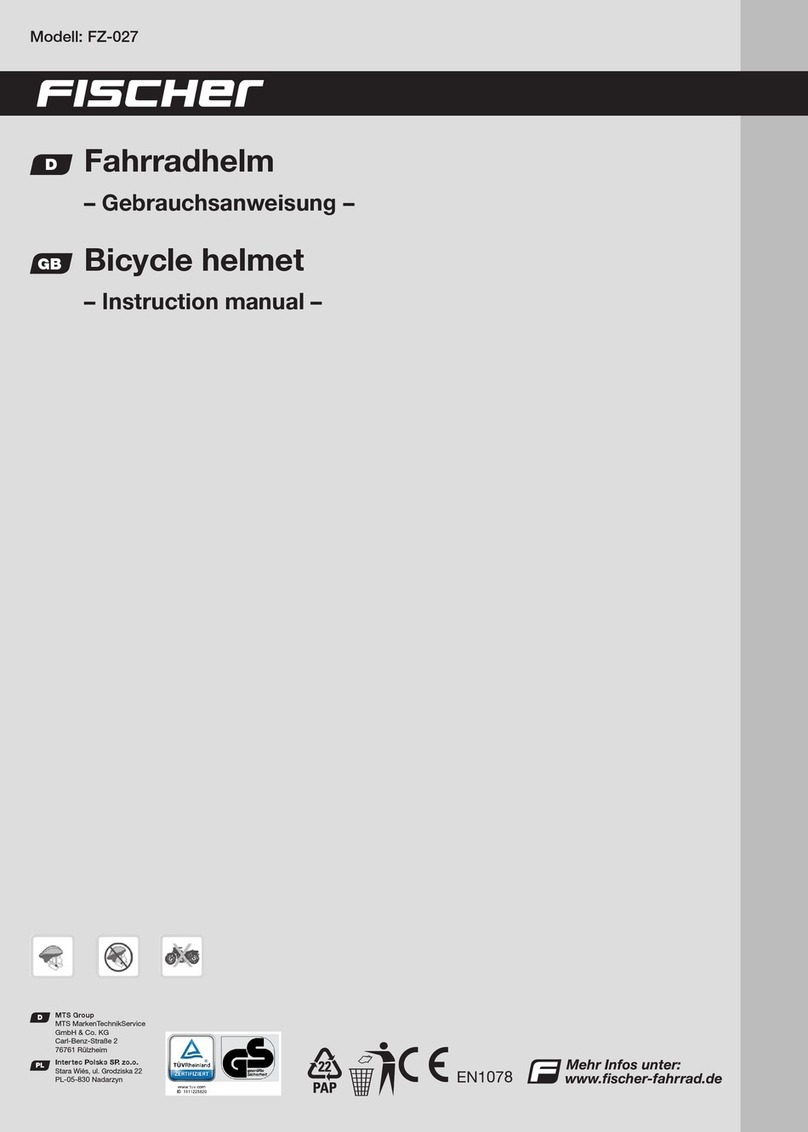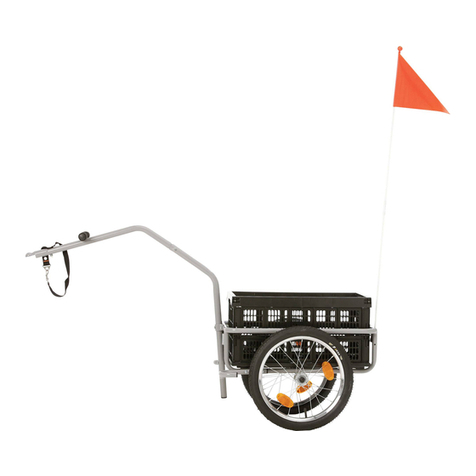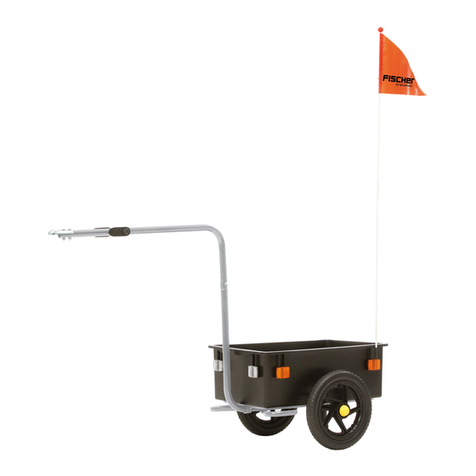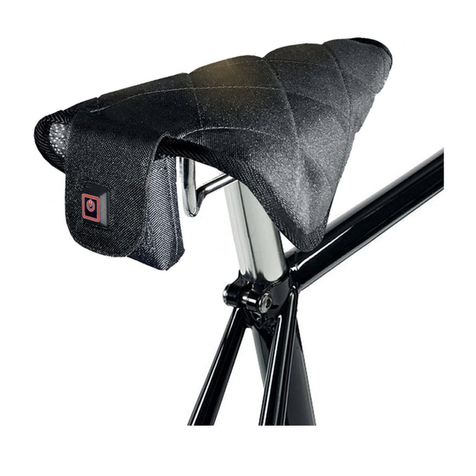FISCHER 50600 User manual

Fahrrad-Kindersitz
– Rahmenbefestigung –
Gebrauchsanweisung
Child seat for bicycles
– frame mounting system –
Instructions for use
Siège à enfants pour bicyclette
– Fixation au cadre –
Manuel d‘utilisation
Seggiolino per bicicletta
– Fissaggio al telaio –
Istruzioni per l‘uso
Rowerowy fotelik dziecięcy
– Mocowanie do ramy –
Instrukcja obsł
Fahrrad-Kindersitz
– Rahmenbefestigung –
D
GB
F
I
PL
Art.-Nr. 50600 - 09/2021
13 mm
N°5
28-40
max.
25 km/h
EN 14344
26˝-
28˝
max.
22 kg
Ø 28-40mm
Rund
Round
Rond
Rotondo
okrag
Oval
Oval
Ovale
Ovale
owal
Viereckig
Rectangular
Carré
Quadrato
kwadrat
Dreieckig
Triangular
Triangulaire
Triangolare
trójkat
Carbonfaser
Carbon fibre
Fibre en carbone
Fibra di carbonio
włókno weglowe

Anleitung / Manual / Manuel / Manuale / Podręcznik
D
Technische Eigenschaften
- Der Fahrrad-Kindersitz darf nicht an Fahrrädern mit
hinteren Stoßdämpfern angebracht werden.
- Der Fahrrad-Kindersitz kann auf 26- und 28-Zoll-
Fahrräder montiert werden.
- Der Fahrrad-Kindersitz kann auf Fahrräder mit Oval-
und Rundrohrrahmen von 28 bis 40 mm Durchmes-
ser montiert werden.
- Geeignet für Pedelecs bis max. 25km/h
- Falls der Gepäckträger die Breite von 175 mm über-
schreitet, muss dieser vorerst entfernt werden, damit
der Fahrrad-Kindersitz sicher befestigt werden kann.
- Sollten Sie bei der Montage des Fahrrad-Kindersitzes
Fragen haben, wenden Sie sich bitte an Ihren Fahr-
radhändler.
GB
Technical Characteristics
- The Child seat for bicycles cannot be mounted on
bicycles with rear shock absorbers.
- The child seat for bicycles can be assembled on bi-
cycles with wheels with diameters of 26” and 28”.
- The child seat for bicycles can be assembled on bi-
cycles with round and oval tubular frames, with diam-
eters ranging from 28 to 40 mm.
- Suitable for pedelecs up to max. 25km/h
- The child seat for bicycles cannot be mounted on bi-
cycles with luggage carriers wider than 175 mm.
- If you have any doubts on assembling the child seat
for bicycles on your bicycle, please contact your bi-
cycle supplier for further information.
F
Caractéristiques techniques
- Ne peut pas être utilisé sur bicyclettes avec amor-
tisseurs arrières.
- Le porte-bébé peut être monté sur des vélos avec
roues de diamètres entre 26” et 28”.
- Le porte-bébé peut être monté sur des vélos pour-
vus d’un cadre de section ronde ou ovale, d’un dia-
mètre compris entre 28 et 40 mm.
- Adaptées pour des Pedelecs jusqu’à max. 25 km/h
- Ne pas utiliser le porte-bébé sur bicyclette ayant
un porte-bagages avec plus de 175 mm de largeur
(dans ce cas démontez le porte-bagages avant de
monter le siège).
- En cas de doute à propos du montage du siège,
veuillez vous adresser à votre fournisseur afin d’ob-
tenir les informations nécessaires.
I
Caratteristiche tecniche
- Il seggiolino non deve essere montato su biciclette
con ammortizzatori sul retro.
- Il sedile per bimbo può essere montato su biciclette
con ruote del diametro di 26” e 28”.
- Il sedile per bimbo può essere montato su biciclette
con telaio in tubolare tondo od ovale, del diametro
compreso tra 28 e 40 mm.
- Adatto per biciclette a pedalata assistita fino a max.
25km/h
- Il seggiolino non deve essere montato su biciclette
con portapacchi superiore a 175 mm di larghezza.
- In caso di dubbio circa il montaggio del sedile sulla
bicicletta, rivolgersi al proprio rivenditore di biciclette
per ulteriori informazioni.
PL
Charakterystyka techniczna
- Fotelik nie może być montowany na rowerach posia-
dających tylne amortyzatory.
- Fotelik dziecięcy można montować na rowerach, któ-
rych koła posiadają średnicę 26 lub 28 cali.
- Fotelik dziecięcy można montować na rowerach
wyposażonych w okrągłe lub owalne ramy rurowe o
średnicy od 28 do 40 mm.
- Do rowerów elektrycznych do maks. 25 km/h
- Fotelik nie może być montowany na rowerach o ba-
gażnikach szerszych niż 175 mm.
- W przypadku wątpliwości dotyczących montażu
fotelika na swoim rowerze, prosimy zasięgnąć infor-
macji u sprzedawcy roweru.
D
Sicherheitshinweise
• Das Mindestalter für den Fahrer des Fahrrads beträgt
16 Jahre;
• Der Fahrrad-Kindersitz wurde speziell für die Beförde-
rung Kindern mit einem Gewicht von max. 22 Kg und
einem Alter von max. 5 Jahren entwickelt. Überprüfen
Sie regelmäßig das Gewicht Ihres Kindes. Kinder mit
einem Gewicht von über 22 Kg dürfen nicht befördert
werden.
• Kinder im Alter von unter 12 Monaten dürfen nicht im
Fahrrad-Kindersitz befördert werden. Es dürfen aus-
schließlich solche Kinder befördert werden, die in der
Lage sind, gerade zu sitzen und den Kopf beim Tra-
gen des Schutzhelms in aufrechter Position zu halten.
Bei Zweifeln hinsichtlich des Entwicklungsstadiums
des Kindes sollte ein Arzt zu Rate gezogen werden.
• Befördern Sie nur Kinder, die für längere Zeit ohne
Hilfe sitzen können, mindestens für die Dauer der ge-
planten Fahrt mit dem Fahrrad.
• Überprüfen Sie nach der Montage des Fahrrad-Kin-
dersitzes das korrekte Funktionieren aller Bestand-
teile des Fahrrads.
• Den Fahrrad-Kindersitz nicht auf Rennräder (mit nach
unten gerichtetem Lenker) montieren.
• Vergewissern Sie sich, dass alle sicherheitsrelevanten
Gurte und Riemen straff ansitzen, jedoch ein beque-
mes Sitzen weiterhin gewährleistet ist;

Anleitung / Manual / Manuel / Manuale / Podręcznik
• Die Lehne des Fahrrad-Kindersitzes sollte leicht nach
hinten gekippt sein, um ein Herausrutschen des Kin-
des auszuschließen.
• Vor Gebrauch des Fahrrad-Kindersitzes unbedingt
den Sicherheitsgurt anpassen.
WARNUNG: Zusätzliche Sicherheitsbefestigungen
müssen immer angebracht werden.
• Stellen sie sicher, dass es für kein Körper- oder Be-
kleidungsteil des Kindes möglich ist, in Kontakt mit
beweglichen Teilen des Sitzes oder Fahrrades zu
kommen, und überprüfen sie dies mit dem Wachsen
des Kindes. Es können die Füße des Kindes in die
Speichen geraten und die Finger in den Bremsme-
chanismus und in die Sattelfedern;
• Das Kind muss mit auf die Wetterverhältnisse abge-
stimmter Kleidung und einem passenden Schutzhelm
ausgestattet sein.
• Das Kind im Sitz soll wärmer als der Fahrer gekleidet
sein und vor Regen geschützt werden.
•
Wenn der Fahrrad-Kindersitz nicht benutzt wird, muss
der Gurt geschlossen sein, damit dieser nicht herunter-
hängt und mit den beweglichen Teilen des Fahrrads wie
Rädern, Bremsen etc. in Berührung kommt und somit
eine Gefahrenquelle für den Fahrradfahrer darstellt.
WARNUNG: Befestigen Sie kein zusätzliches Gepäck
an dem Fahrrad-Kindersitz.
WARNUNG: Am Sitz dürfen keine Änderungen vorge-
nommen werden.
• Wird zusätzliches Gepäck mitbefördert, darf dies die
zulässige Maximallast des Fahrrads nicht übersteigen
und muss vor dem Fahrer befördert werden.
WARNUNG: Das Fahrverhalten des Fahrrades kann mit
dem Kind im Sitz anders sein. Speziell in Bezug auf die
Balance, die Lenkung und das Bremsen.
WARNUNG: Das Fahrrad darf nie geparkt
werden, wenn das Kind unbeaufsichtigt im
Sitz ist.
• Überprüfen Sie die Schrauben regelmäßig auf festen
Sitz und ersetzen Sie sie erforderlichenfalls.
WARNUNG: Der Sitz darf nicht verwendet werden,
wenn irgendein Teil defekt ist.
• Die Position des Fahrrad-Kindersitzes muss so an-
gepaßt werden, dass der Fahrradfahrer während der
Fahrt nicht versehentlich mit den Füßen an den Fahr-
rad-Kindersitz stößt.
• Das Gesamtgewicht von Fahrradfahrer und beför-
dertem Kind darf das für das Fahrrad zugelassene
Höchstgewicht nicht überschreiten. Informationen
über die zulässige Höchstlast können aus der Bedie-
nungsanleitung des Fahrrads entnommen oder beim
Fahrradhändler eingeholt werden.
• Stellen Sie stets sicher, dass das beförderte Kind
nicht mit spitzen Teilen des Fahrrads in Berührung
kommen kann
•
Bei längerer Sonneneinstrahlung können sich Sitz
und Polsterung stark erhitzen. Vergewissern Sie sich
vor Benutzen des Sitzes, dass dieser nicht zu heiß
für das Kind ist.
• Vor dem Transport des Fahrrads auf einem Dach-
gepäck- bzw. Heckträger muss der Fahrrad-Kinder-
sitz abgenommen werden, um Beschädigungen des
Sitzes durch den Fahrtwind zu vermeiden. Es kann
sich auch die Befestigung am Fahrrad lösen, was zu
einem Unfall führen kann.
• Überprüfen Sie nach der Montage das korrekte Funk-
tionieren des Sitzes.
• Bitte machen Sie sich mit den in Ihrem Land gelten-
den gesetzlichen Bestimmungen und Vorschriften
bezüglich der Beförderung von Kindern in Fahrrad-
Kindersitzen vertraut.
• Verwenden sie immer die Gurte zur Sicherung des
Kindes.
• Decken sie offen liegende Sattelfedern ab.
GB
Safety Instructions and Warnings
• The rider must be at least 16 years of age;
• The child seat for bicycles is only suitable for trans-
port children with a maximum weight of 48.5 lbs /
22 kg, with an age limit of 5 years. Check the child’s
weight regularly and do not carry a child that weighs
more than this.
• Do not carry a child less than 12 months of age, in this
child seat for bicycles. To be a passenger, the child
must be able to sit up straight with the head held up-
right while wearing a bicycle helmet. A doctor should
be consulted it the child’s growth in questionable.
• Only transport children who can sit unaided for a long
period of time, at least for the duration of the planned
trip with the bicycle.
• Check if all parts of the bicycle function correctly
with the child seat for bicycles mounted.
• Do not install this child seat for bicycles on a racing
bicycle (drop handlebar).
• Secure the child on child seat for bicycles ensuring
that all the safety belts and straps applied firmly but
not so tight as to cause discomfort to the child;
• Make sure the seat stays slightly reclined towards
the back and not towards the front, to avoid the child
from slipping.
• The child seat for bicycles must never be used be-
fore adjusting the safety belt.
WARNING: Additional security devices shall always
be fastened.
• Do not allow any part of the child’s body or clothing,
shoelaces, child seat for bicycles belts, etc. to come
in contact with moving parts of the bicycle because
can be harmful to the child or cause accidents.
• A wheel protector is recommended to prevent the
child from inserting its feet or hands between the
spokes. The use of pro tection underneath the sad-
dle or the use of a saddle with internal springs is
mandatory. Make certain that the child is not able to
hinder the brakes, thus avoiding accidents. These
adjustments should be revised with child´s growth.
• Dress the child with proper clothes according to
weather conditions and use an appropriate helmet.
• The children in seats need to be more warmly clothed
than riders of cycles and should be protected from rain.

Anleitung / Manual / Manuel / Manuale / Podręcznik
• When the child seat for bicycles is not in use, fasten
the waist buckle of the security harness to prevent
the straps from dangling and entering in contact with
some turning part of the bicycle as wheels, brakes,
etc. as these may be a hazard to the cyclist.
WARNING: Do not attach additional luggage to the
child carrier.
WARNING: Do not modify the seat.
• If you carry additional luggage its weight must not
exceed the bicycle’s carrying capacity and it must
be carried in front of the rider.
WARNING: The cycle may behave differently with a
child in the seat particularly with regard to balance,
steering and braking.
WARNING: Never leave the cycle parked
with a child in the seat unattended.
• Check the screws regularly and replace any when
required.
WARNING: Do not use the seat if any part is broken.
• The position of the child seat for bicycles must be
adjusted so that the bicycle rider does not touch the
child seat for bicycles with the feet when in motion.
• The weight of the rider and the child carried must
never be more than the maximum load allowed for
the bicycle. Check the bicycle instructions manual
on the bicycle supplier to make sure if the bicycle
supports this additional load.
• You must cover any sharp or pointy object of the
bicycle that may be reached by the child.
• The seat and cushion can get hot if under the sun for
a long time. Make sure that they aren’t too hot before
seating the child.
• When transporting the bike on luggage racks or bi-
cycle racks on the car roof or boot door, always take
the child seat off the bike. The drag could damage
it or tear it off the child seat for bicycles. The attach-
ment to the bicycle can also come loose, which can
lead to an accident.
• Check that the seat functions correctly when mounted.
• Check the laws and regulations in your country, re-
lated to carrying children in seats attached to cycles
in force.
• Always use the belts to secure the child.
• Cover exposed saddle springs.
F
Instructions de sécurité et avertissements
• Le conducteur de la bicyclette doit être âgé de 16
ans au moins.
• Ce porte-bébé n’est prévu que pour le transport
d’enfants d’un poids maximum de 22 kg et âgés au
plus de 5 ans. Vérifiez le poids de l’enfant avant tout
usage du siège. N’utilisez en aucun cas ce siège
pour des enfants dont le poids est supérieur aux
limites fixées.
• N’utilisez pas ce siège pour des enfants de moins de
12 mois. Pour circuler comme passager, l’enfant doit
pouvoir s’asseoir avec le dos en position verticale et
la tête droite lorsqu’il porte un casque de protection.
Consultez un médecin si l’enfant présente des pro-
blèmes de développement.
• Transportez uniquement des enfants qui peuvent
s’asseoir sans aide pendant une durée prolongée, au
moins pour la durée du trajet prévu avec le vélo.
• Vérifiez que tous les éléments de la bicyclette fonc-
tionnent correctement lorsque le porte-bébé est
monté.
• N’installez pas ce siège sur un vélo de course (gui-
don bas).
• Attachez l’enfant au siège en vous assurant que les
ceintures de sécurité et les courroies sont bien en
place et correctement serrées (sans excès toutefois,
afin que l’enfant n’éprouve aucune gêne).
• Assurez-vous également que le siège est légèrement
incliné vers l’arrière et non vers l’avant, afin que l’en-
fant ne glisse pas.
• N’utilisez jamais le siège d’enfant avant d’avoir
ajusté la ceinture de sécurité.
AVERTISSEMENT: Fixez toujours les dispositifs de
sécurité supplémentaires.
• Vérifiez qu’en toutes circonstances aucune partie
du corps de l’enfant ou de ses vêtements (lacets,
ceintures de sécurité, etc.) ne puisse se trouver en
contact avec une partie mobile de la bicyclette, ce
qui pourrait blesser l’enfant ou provoquer un accident.
• Nous vous recommandons d’installer une protec-
tion sur la roue afin d’éviter que l’enfant ne mette
ses pieds ou ses mains dans les rayons. L’utilisation
d’une protection sous la selle ou d’une selle dotée
de ressorts internes est obligatoire et vous devrez
vous assurer que l’enfant n’a pas accès à la zone
des freins pour éviter tout accident.
• Habillez votre enfant avec des vêtements chauds et
équipez-le d’un casque approprié.
• Les enfants assis sur les sièges doivent être plus
chaudement vêtus que les conducteurs, ils doivent
également être protégés de la pluie.
• Lorsque le siège n’est pas utilisé, bouclez la cein-
ture du harnais de sécurité : les boucles pendantes
peuvent entrer en contact avec des parties mobiles
(roues, freins, etc.) et présentent un danger pour le
cycliste.
AVERTISSEMENT: N‘ajoutez pas de bagage supplé-
mentaire au siège.
AVERTISSEMENT: Ne modifiez pas le siège ;
• Si vous transportez un bagage supplémentaire, ce-
lui-ci ne doit pas dépasser la capacité de charge du
vélo et doit être transporté à l’avant.
AVERTISSEMENT: La bicyclette peut avoir un com-
portement différent lorsque le siège est occupé ;
AVERTISSEMENT: Ne jamais laisser la bi-
cyclette garée avec un enfant dans le siège
sans surveillance ;
• Vérifiez régulièrement l’état des vis et remplacez-les
si besoin est.
AVERTISSEMENT: N‘utilisez jamais le porte-bébé si
l‘une de ses pièces est défectueuse ou endommagée.

Anleitung / Manual / Manuel / Manuale / Podręcznik
• La position du siège d’enfant doit être ajustée afin
que le conducteur ne le touche jamais avec les pieds
lorsqu’il pédale.
• Le poids cumulé du conducteur et de l’enfant ne doit
jamais excéder la charge maximum autorisée pour
votre bicyclette. Vérifiez dans le manuel de votre
bicyclette ou auprès de votre revendeur que cette
charge supplémentaire est supportée.
• Veillez à protéger tout élément pointu de la bicyclette
pouvant être atteint par l’enfant.
• Le siège et le rembourrage peuvent être très chauds
s’ils sont exposés longtemps au soleil : assurez-vous
qu’ils ne sont pas brûlants avant d’asseoir l’enfant.
• Lorsque vous transportez la bicyclette sur le porte-
bagages d’une voiture ou au moyen d’un porte-
vélo sur hayon, retirez toujours le porte-bébé : le
vent pourrait l’endommager ou même l’arracher.
La fixation au niveau de la bicyclette peut éga-
lement se détacher, ce qui peut entraîner un ac-
cident.
• Vérifiez que le porte-bébé fonctionne correctement
une fois monté.
• Vérifiez les lois et règlements en vigueur dans votre
pays concernant le transport d’enfants à bicyclette.
• Utilisez toujours les ceintures pour la sécurisation de
l’enfant.
• Couvrez des ressorts de selle visibles.
I
Istruzioni di sicurezza e avvertenze
• Il conducente deve avere almeno 16 anni di età.
• Il presente sedile è esclusivamente idoneo al tra-
sporto di bambini del peso massimo di 48,5 lbs / 22
kg e fino all’età di 5 anni. Si raccomanda di verificare
il peso del bambino prima di utilizzare il sedile. In
nessuna circostanza si dovrà usare questo sedile
per trasportare bambini il cui peso eccede il limite
consentito.
• Non trasportare su questo sedile bambini di età infe-
riore a 12 mesi. Per poter essere trasportato, il bam-
bino deve essere in grado di mantenersi seduto, con
la testa eretta, indossando un casco da bicicletta.
Consultare un medico se la crescita del bambino
mette in dubbio l’idoneità del sedile.
• Trasportare solo bambini che possono stare seduti a
lungo senza aiuto, almeno per la durata del viaggio in
bicicletta previsto.
• Controllare che tutte le parti della bicicletta funzio-
nino regolarmente, con il sedile portabebè installato.
• Non installare questo sedile su biciclette da corsa.
• Assicurare il bambino al sedile, controllando che
tutte le cinture di sicurezza e le cinghie siano allac-
ciate saldamente, ma non così strette da disturbare
il bambino.
• Accertarsi che il sedile si trovi leggermente reclinato
all’indietro e non in avanti, per evitare che il bambino
possa scivolare.
• Non utilizzare mai il sedile portabebè prima di avere
regolato la cintura di sicurezza.
AVVERTENZA: I dispositivi di sicurezza supplemen-
tari devono sempre essere fissati.
• Evitare che parti del corpo o dell’abbigliamento del
bambino, lacci di scarpe, cinture del sedile, ecc.,
vengano a contatto con le parti in movimento della
bicicletta, poiché possono ferire il bambino o cau-
sare gravi incidenti.
• Si raccomanda di applicare una protezione sulla
ruota per evitare che il bambino introduca i piedi o le
mani nei raggi. È obbligatorio inserire una protezione
sotto il sellino oppure un sellino dotato di molle in-
terne, e verificare che il bambino non abbia accesso
alla zona dei freni, al fine di evitare incidenti.
• Vestire il bambino con indumenti adeguati alle con-
dizioni meteorologiche, e utilizzare un idoneo casco.
• Il bambino nel seggiolino deve indossare indumenti
più pesanti del guidatore e deve essere protetto
dalla pioggia.
• Quando il sedile non è in uso, allacciare la fibbia
della cintura di sicurezza, per impedire che le cin-
ghie penzolanti entrino in contatto con le parti rotanti
della bicicletta, come ruote, freni, ecc., rappresen-
tando un rischio per il ciclista.
AVVERTENZA: Non applicare bagaglio supplemen-
tare sul seggiolino.
AVVERTENZA: Non modificare il seggiolino.
• Se si trasportano bagagli supplementari, questi
non dovranno superare la capacità di carico della
bicicletta e dovranno essere trasportati nella parte
anteriore.
AVVERTENZA: La manovrabilità della bicicletta può
essere differente con un bambino nel seggiolino, in
particolare per quanto riguarda l’equilibrio, lo sterzo
e i freni.
AVVERTENZA: Non lasciare mai la bici-
cletta parcheggiata con un bambino incu-
stodito nel seggiolino.
• Verificare regolarmente lo stato dei bulloni e sostitu-
irli se necessario.
AVVERTENZA: Non usare il seggiolino se una qualsi-
asi parte è rotta.
• La posizione del sedile deve essere regolata in modo
che il conducente della bicicletta non tocchi il sedile
con i piedi durante il movimento.
• Il peso del conducente e del bambino trasportato
non deve mai superare il carico massimo consentito
per la bicicletta. Consultare il manuale di istruzioni
della bicicletta o rivolgersi al produttore per accer-
tarsi che la bicicletta possa sostenere questo carico
addizionale.
• Proteggere eventuali oggetti appuntiti della struttura
della bicicletta che possono essere alla portata del
bambino.
• Il sedile e l’imbottitura possono riscaldarsi, se espo-
sti al sole per periodi prolungati. Accertarsi che non
siano troppo caldi prima di accomodarvi il bambino.
• Quando si trasporta la bicicletta sul portapacchi o su
una rastrelliera, sul tetto dell’automobile, rimuovere
sempre il sedile portabebè dalla bicicletta. In que-
sto modo si evita il rischio che si danneggi o venga
Other FISCHER Bicycle Accessories manuals
Popular Bicycle Accessories manuals by other brands

Specialized
Specialized Elite CylcoComputer user manual

Sigma
Sigma BC 16.16 manual

Playcore
Playcore Dero Setbacks installation instructions

VDO Cyclecomputing
VDO Cyclecomputing x3dw instruction manual

Cateye
Cateye RAPID X2 manual

buratti meccanica
buratti meccanica Clorofilla Trail Use and maintenance manual

















